What is a Light Medium Duty Racking System?
A Light Medium Duty Racking System is an efficient storage solution designed to optimize space and manage inventory in small to medium-sized warehouses. With a load capacity ranging from 50kg to 1,000kg per tier, these racks are constructed from galvanized or powder-coated steel, ensuring durability and rust resistance.
Light-duty racking systems are commonly made from galvanized steel, metal, featuring a simple design that is easy to assemble and relocate. Thanks to their flexible structure, these racks allow users to quickly arrange and adjust storage configurations as needed. In contrast, medium-duty racking is specifically designed to accommodate goods with greater weight and size, making it well-suited for environments that require higher load-bearing capacity.
Featuring a modular design, they are easy to assemble and disassemble using bolts, making them ideal for storing a variety of goods, including cartons, small components, documents, or display products in retail and fashion warehouses.
Eurorack’s light and medium-duty racking systems serve a wide range of industries, including retail, e-commerce, document storage, and fashion. With their flexible design and cost-effective pricing, they are an ideal choice for small and medium-sized businesses or for storing goods that are not excessively heavy, aiming to optimize storage space efficiently.
Eurorack’s Light Medium Duty Racking Systems
Eurorack’s light and medium-duty racking systems consist of seven distinct products, including: Medium Duty Racking, V-Hole Shelving, Carton Flow Racking, Supermarket Shelves, Library Shelving, and Garment Racking. Each product is specifically designed to meet unique storage needs, with detailed information on its features, advantages, disadvantages, and applications.
1. Medium Duty Racking
Features:
- Load capacity under 1000kg per tier.
- Comprises load-bearing uprights, bracing, beams, and steel/wood/mesh shelves.
- Bolt-assembled, no pallets or forklifts required.
Advantages:
- Cost-Effectiveness: Much more economical than heavy duty shelving systems, suitable for areas that are not too large. Anti-rust coating reduces maintenance costs.
- Space Efficiency: The multi-tier design (3-7 tiers, up to 4.5 m) boosts storage density by 60%, enabling a 300 m² warehouse to store 50% more inventory.
- Flexibility: The bolt-on modular design allows for easy level adjustment – for example, a 5-tier shelf configuration can be quickly changed to a 3-tier or 7-tier shelf.
- Ease of Installation: Tool-free bolt-and-screw assembly enables two workers to install a three-tier rack (1200x400x1700 mm) in 5-10 minutes, minimizing downtime.
- Durability and Safety: Hoa Phat Posco steel with anti-rust coating ensures a 10-15 year lifespan, safely supporting up to 700 kg/tier per ISO 9001:2015 standards.
- Efficient Inventory Management: Organized multi-tier layout reduces retrieval time by 40%, with dividers on four-tier racks streamlining textile warehouse operations.
- Aesthetic Appeal: Blue-orange electrostatic coating, customizable to brand colors, enhances professional appeal in retail settings like hardware stores.
Applications:
- Ideal for retail warehouses, distribution centers, or small industrial warehouses storing auto parts, electronics, fast-moving consumer goods (FMCG), or cartons.
- Suitable for businesses managing diverse inventory with varying sizes and weights, such as component or consumer goods warehouses.
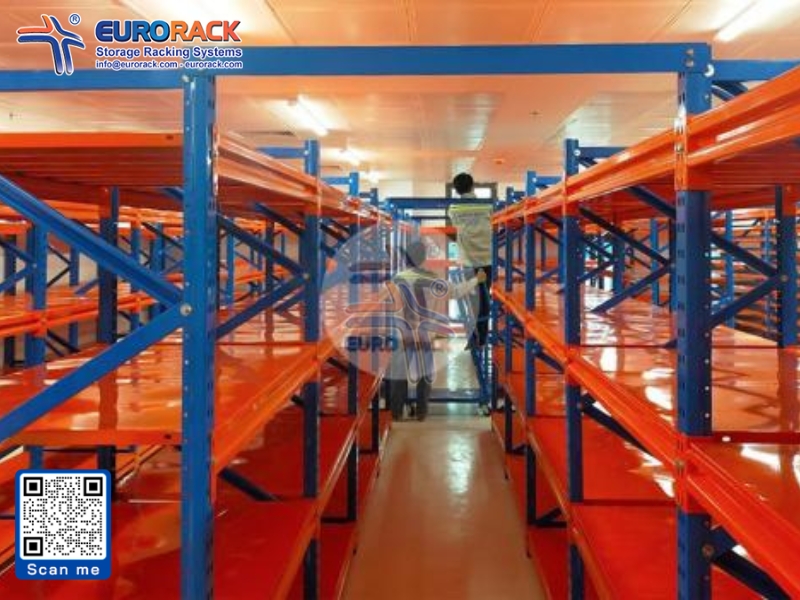
2. V-Hole Shelving
Features:
- Supports up to 300kg per tier.
- V-shaped perforated steel uprights for adjustable tier height.
- Bolt and screw assembly, no beams required.
- Customizable sizes for storage needs.
Advantages:
- Easy Installation: The bolt-and-screw design enables tool-free assembly of a 4-6 tier V-Hole Shelving unit in under an hour, ideal for businesses and households.
- Reduced Labor Costs: The modular structure allows a single person to install or adjust shelves, with free inner-city installation by Eurorack minimizing labor expenses.
- Customization Options: V-Hole Shelves provide 2-8 plates, pillar sizes (V1x3cm to V4x8cm), and custom dimensions (up to 2.5m high, 60-150cm long) to fit any storage need.
- Versatility: Supporting 100-300 kg per plate, the compact design suits warehouses, retail displays, offices, and homes, accommodating electronics to groceries.
- Durability: Cold-rolled steel with electrostatic or galvanized coating ensures an 8-12 year lifespan, resisting rust per ISO 9001:2015 standards.
- Ease of Use: Adjustable tray heights and intuitive design simplify loading, inventory management, and cleaning for efficient storage operations.
Applications:
- Suitable for small warehouses, mini supermarkets, convenience stores, or offices storing documents, small parts, or display goods like household goods or packaged food.
- Used in homes for storing personal items, books, or decorative objects.
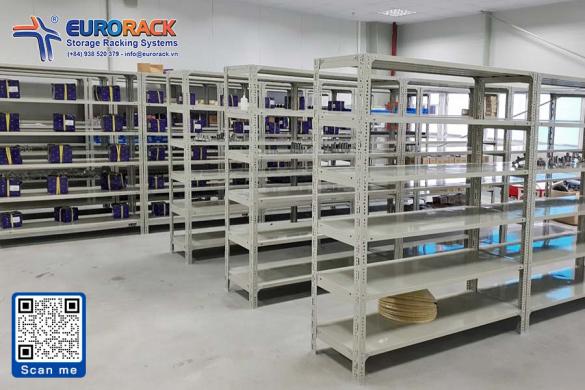
3. Carton Flow Racking
Features:
- Supports 50kg to 150kg per roller.
- Height: 1.2m to 3.5m (customizable).
- Uses plastic, rubber, or metal rollers on an inclined plane to move goods from high to low end.
- Steel shelves with electrostatic powder coating or galvanizing.
- Structure includes upright frames, beams, bracing, roller system, and stoppers.
Advantages:
- Increased Efficiency: The gravity-fed roller system reduces retrieval time by up to 50% by automatically moving cartons from loading to picking sides.
- Labor Costs Savings: Minimized manual effort in locating cartons allows workers to operate efficiently, reducing physical strain and repetitive task time.
- Improved Inventory Management: FIFO operation ensures older stock like food or pharmaceuticals is picked first, minimizing spoilage and ensuring compliance.
- High-Density Storage: Maximizing vertical and horizontal space, the system reduces storage needs by 30%, ideal for urban warehouses.
- Enhanced Product Visibility: Multi-lane configuration organizes cartons by SKU, reducing picking errors in fast-paced environments.
- Easy Installation and Modularity: Modular design enables tool-free assembly in 1-2 days, with easy reconfiguration for future needs.
- Seamless Integration: Integration with pallet racking combines high-density carton and bulk storage, streamlining centralized inventory management.
Applications:
- Ideal for e-commerce warehouses, distribution centers, or supermarkets managing small SKUs like food, beverages, pharmaceuticals, or packaged accessories.
- Suitable for warehouses using FIFO to ensure fresh inventory and minimize spoilage.

4. Supermarket Shelves
Features:
- Supports 50kg to 150kg per tier.
- 0.8-0.85mm thick tole shelves, multi-tier with dividers, optional hooks or mesh backs.
- Customizable sizes, adjustable tiers.
Advantages:
- Space Optimization: Multi-layered design (3-8 floors, up to 2100mm) boosts storage capacity by 30%, ideal for compact urban stores.
- Convenience and Flexibility: Lightweight shelves assemble in under 1 hour with screws and bolts, enabling rapid store reconfigurations.
- High Aesthetics: Vibrant white-blue shelves with sophisticated designs boost customer engagement by 10-15%, highlighting new merchandise.
- Solid and Durable Structure: High-quality iron with electrostatic coating ensures over 10 years of durability, supporting 50-150 kg per floor.
- Versatile Customization: Mesh, corrugated, or perforated backs cater to diverse store aesthetics and product types like snacks or electronics.
Applications:
- Ideal for supermarkets, convenience stores, or fashion shops displaying food, beverages, accessories, or footwear.
- Suitable for retail spaces aiming to create professional, attractive product arrangements to enhance the shopping experience.
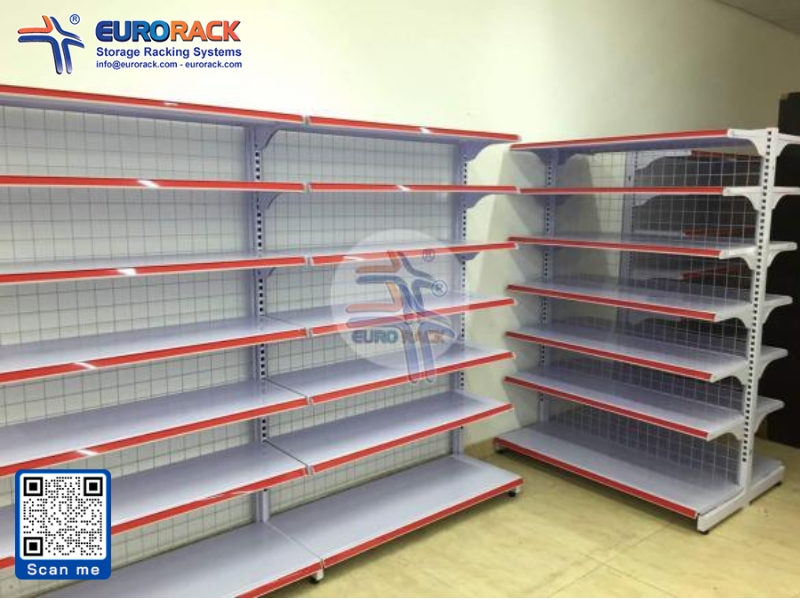
5. Library Shelving
Features:
- Supports 50kg to 150kg per tier.
- Designed for specialized shelving for books, documents, or specialized shelving with files, with dividers or shelves for easy access.
- Standard dimensions:
- Height: 1500mm, 1,800mm, 2,000mm (customizable).
- Length: 600mm, 800mm, 1000mm (customizable).
- Width: 300mm, 400mm, 500mm (customizable).
- Bolt-assembled with steel or wooden shelves, powder-coated or galvanized.
- Optional add-ons such as adjustable shelves, dividers, or shelf tags.
Advantages:
- Enhanced Organization: Compartmentalized tiers with labeling systems streamline book categorization by genre or type, boosting efficiency in libraries.
- Improved Space Utilization: Multi-tiered design (2-6 tiers, 1500-2000 mm) doubles storage capacity, ideal for compact bookstores or home offices.
- Accessibility for Patrons: Ergonomic heights (1500-2000 mm) and mobile layouts ensure easy access for all, enhancing browsing in busy libraries.
- Durability: Premium steel with EN-compliant electrostatic coating supports 200 kg per layer, ensuring a 15+ year lifespan for heavy loads.
- Aesthetics: Sleek designs with customizable colors create vibrant or professional settings, elevating library or office ambiance.
- Flexibility: Customizable sizes (600-1000 mm length) and quick assembly (under 1 hour) allow easy reconfiguration for seasonal displays or events.
- Maintenance: Electrostatic coating resists dust and rust, enabling easy cleaning with a damp cloth for low-maintenance library use.
Applications:
- Ideal for libraries, bookstores, schools, offices, or corporate archives, corporate offices, or offices needing to manage books, medical/legal documents, or reports.
- Suitable for organized for organized, accessible, and visually appealing document storage in public or professional settings like libraries, hospitals, or law libraries.
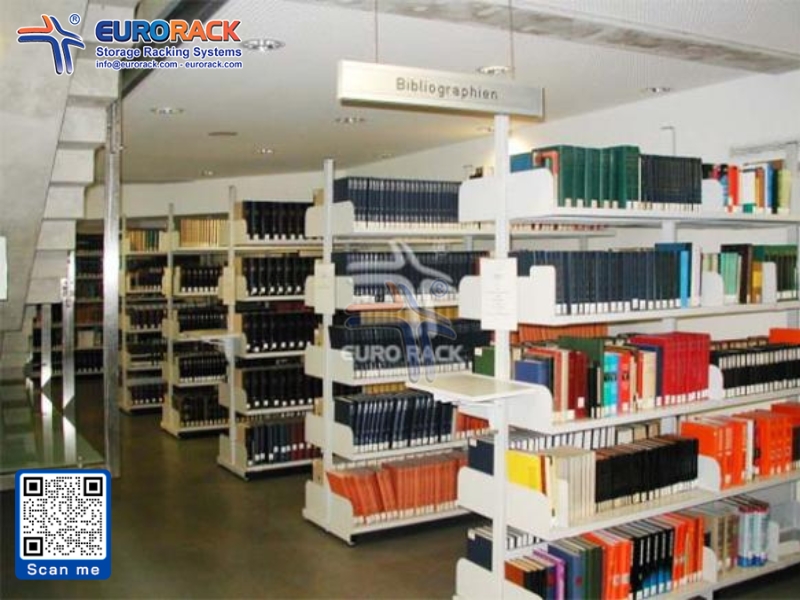
6. Garment Racking
Features:
- Supports 50kg to 150kg per side.
- Designed for hanging clothes, with optional shelves for cartons.
- Structure includes upright frames, horizontal braces, load beams, and support bars.
- High-quality steel with powder-coated finish, customizable sizes.
Advantages:
- Improved Organization: Customizable 1-3 tiers with dividers allow precise clothing sorting by type or season, streamlining inventory in boutiques.
- Space Efficiency: Compact 915x610x2135 mm design boosts storage density 2-3 times, ideal for small retail spaces or warehouses.
- Wrinkle Prevention: Hanging storage with sturdy steel frames preserves garments like silk dresses, reducing ironing needs for retailers.
- High Durability: Thick steel with electrostatic or galvanized coating ensures a 10+ year lifespan, supporting 200 kg per compartment reliably.
- High Flexibility: Bolt-based assembly enables reconfiguration in under an hour, adapting to oversized gowns or seasonal displays.
- Easy Maintenance and Low Cost: Dust-resistant coating simplifies cleaning, with affordable pricing making it cost-effective for businesses.
Applications:
- Suitable for fashion stores, garment warehouses, or textile factories for storing and displaying clothing, bags, or footwear.
- Used in retail fashion spaces to create attractive, organized displays that enhance customer experience.
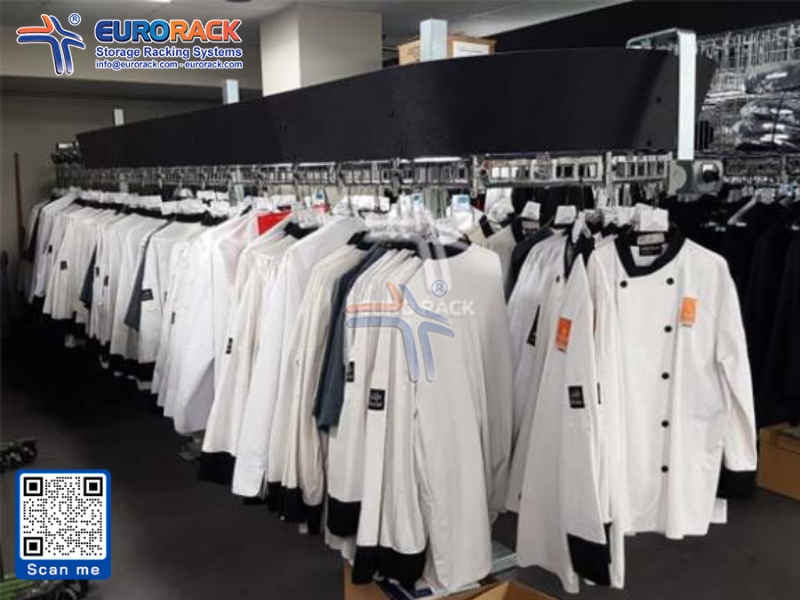
How Light Medium Duty Racking Systems Work?
The light medium duty racking system is designed to streamline storage and inventory management for both manual and semi-automated warehouses. The operational process includes:
- Receiving and Sorting Goods: Goods are inspected and categorized by size, type, and weight (e.g., cartons, clothing, documents) to determine the appropriate rack type, such as Carton Flow for small SKUs or Garment Racking for clothing.
- Loading Goods: Lightweight items are loaded manually (e.g., on V-Hole Shelving), while medium-weight items use forklifts (e.g., Medium Duty Racking). Carton Flow racks automate retrieval with inclined rollers.
- Inventory Management and Retrieval: Deliver streamlined and orderly storage solutions for a wide range of items, from small components to larger, heavier products, primarily in warehouses, retail outlets, and office environments.
- Stock Auditing: Clear layouts enable rapid inventory checks, minimizing errors. Racks like Carton Flow ensure precise management of documents or SKUs. Requiring minimal technology, these systems support rapid deployment, cost savings, and high efficiency, making them ideal for businesses seeking practical storage solutions.
Industries Benefiting from Light Medium Duty Racking
Eurorack’s light medium duty racking systems are widely applied across various sectors due to their versatility and efficiency:
- Retail and Supermarkets: Supermarket create attractive, organized displays for food, beverages, or accessories, boosting sales and customer satisfaction.
- E-commerce: Carton Flow and Medium Duty Racks accelerate order processing and manage diverse SKUs, critical for peak seasons like Black Friday or holidays.
- Fashion: Garment Racks optimize clothing storage and display, ideal for fashion retail or textile warehouses, keeping products wrinkle-free and accessible.
- Small Warehouses and Offices: V-Hole Shelving and Medium Duty Racks efficiently store components, small parts, or lightweight goods in workshops or offices.
The Trend of Using Light Medium Duty Racking
With the rapid growth of e-commerce and the retail industry, along with the rising demand for flexible and cost-effective storage solutions, light and medium-duty racking systems have become increasingly important. These systems can boost storage density by up to 80% and reduce order processing time by up to 30% compared to traditional methods.
Such racking systems are becoming increasingly popular among small and medium-sized businesses looking to optimize warehouse or store space without investing in large-scale systems. The use of high-quality steel with anti-corrosion coatings also aligns with global trends toward sustainable, safe, and internationally certified storage solutions.
Eurorack - The Professional Light Medium Duty Racking Manufacturer
Eurorack is a trusted brand with over 14 years of experience in manufacturing and supplying warehouse racking systems, serving major clients like Coca-Cola, Ajinomoto, Nestlé, Vinamilk, and PepsiCo across Vietnam, the US, Australia, Canada, and Europe. Committed to delivering optimal storage solutions, Eurorack has earned a reputation for quality products and exceptional service.
Why you should choose Eurorack:
- High-Quality Materials: Using galvanized or powder-coated steel meeting ISO 9001:2015, ensuring durability and safety.
- Advanced Manufacturing: Operates factories totaling over 10,000m², equipped with Japan and Europe-imported machinery using CNC, laser, and automation technologies for precision.
- Competitive Pricing: Direct manufacturing eliminates intermediaries, offering affordable prices.
- Professional Services: Comprehensive consultation, design, installation, and maintenance, with detailed video guides or on-site support for nearby customers.
- Long-Term Warranty: Long-Term warranty with continuous technical support, ensuring long-term customer satisfaction.
- Social Responsibility: Supports communities through disaster relief in central Vietnam and sponsors initiatives like the MERC 2023-2024 Robotics Competition, fostering young talent in automation.
Common Questions About Light Medium Duty Racking
1. Which warehouses are suitable for light medium duty racks?
Suitable for small to medium warehouses, retail stores, fashion shops, offices, or document storage facilities requiring flexible, cost-effective storage.
2. What is the cost of installing light medium duty racks?
Depending on size, type, and customization. Contact (+84) 938 520 379 for a detailed quote and free consultation.
3. What is the maximum load capacity of light medium duty racks?
From 50kg to 1,000kg per tier, depending on the rack type (e.g., Medium Duty Racking up to 1,000kg).
4. What types are included in the light medium duty category?
Includes Medium Duty Racking, V-Hole Shelves, Carton Flow Racking, Supermarket Shelves, Library Shelving, and Garment Racking, addressing diverse storage and display needs.
5. Are light medium duty racks durable and safe?
Eurorack’s Racks meet ISO 9001:2015 standards, with a lifespan of 5-10 years, and premium models up to 15 years. Anti-corrosion coatings and sturdy designs ensure safety for goods and workers.
6. How are light medium duty racks delivered and installed?
Racks are delivered disassembled to reduce transport costs and enable easy relocation. Eurorack provides video installation guides or on-site support for nearby customers.





